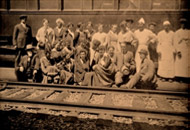1920 — 1940
The Modern architecture period began in the 1920s and was broken into two distinct types: the Art Moderne and the Art Deco. Modern architecture grew out of the destruction of World War I and an architectural need to start anew in terms of society and aesthetics, along with the need for quick construction as the industrial centers in the United States and Europe expanded following the war. Previous architectural styles were bulky and expensive to construct but as industry modernized. Modernistic architecture allowed for fast and relatively cheap construction.
Art Deco was rarely used beyond the building of public buildings and was characterized by smooth, often stucco-clad walls with stylized geometric motifs and tower projections that emphasized the vertical elements. Art Moderne, in comparison, emphasized the horizontal lines by using horizontal grooves on the walls, flat roof, balustrades, and vertical coping along the roof line. Some Art Moderne structures also employed glass blocks for use on windows and even entire sections of walls. This style would also sometimes have one or more curved walls along with long strings of windows that in some cases actually ran around the comer of the structure.


Share Your Comments & Feedback: